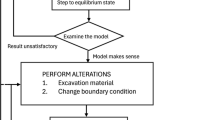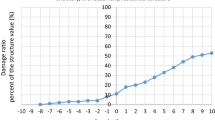Abstract
The high frequency of landslide hazards has caused great human casualties and economic losses in recent years around the world. Among the current available approaches to assess landslide hazard, deterministic approach provides the best quantitative information on landslide hazard which can be used directly in the design of engineering works. However, the approach is difficult to be applied to estimate the slope stability in large scale due to two problems: (1) detailed datasets about the spatial variation of input parameters of the hydrological and slope stability models cannot be acquired easily; (2) an efficient method to divide large-scale area into small mapping units that can be used as study objects for deterministic approach is required. To solve these two problems, all the spatial data involving the physical properties of a slope are modelled in 2D planar or 3D perspective, utilizing the strong spatial data modelling and interpolation capabilities of geographic information system. In addition, a new slope unit division method is also proposed to divide an artificial slope into many small slope units as the study objects for deterministic model. The objective of this study was to propose a set of procedure to evaluate the artificial slope stability along a highway. A 3D limit equilibrium model is used to calculate stability of each slope unit in the form of safety factor. After the safety factors of all slope units are calculated, the stability of the whole area can be assessed.
















Similar content being viewed by others
References
Aleotti P, Chowdhury R (1999) Landslide hazard assessment: summary review and new perspectives. Bull Eng Geol Environ 58(1):21–44
Carrara A (1983) Multivariate methods for landslide hazard evaluation. Math Geol 15:403–426
Carrara A, Cardinali M, Guzzetti F, Reichenbach P (1995) GIS-based techniques for mapping landslide hazard. In: Carrara A, Guzzetti F (eds) Geographical information systems in assessing natural hazards. Kluwer, The Netherlands, pp 135–176
Hansen A (1984) Landslide hazard analysis. In: Brunsden D, Prior DB (eds) Slope instability. Wiley, New York, pp 523–602
Hutchinson JN (1995) Landslide hazard assessment. Keynote paper. In: Bell DH (ed) Landslides. Proceeding of 6th international symposium on landslides, Christchurch, New Zealand, vol 1. Balkema, Rotterdam, pp 1805–1841
Mark RK, Ellen SD (1995) Statistical and simulation models for mapping debris-flows hazard. In: Carrara A, Guzzetti F (eds) Geographical information systems in assessing natural hazards. Kluwer, The Netherlands, pp 93–106
Qiu C (2007) Development of a GIS-based three-dimensional deterministic methodology for spatio-temporal assessment of landslide hazard. PhD thesis, Kyushu University, 84 pp
Sahu KC (2007) Textbook of remote sensing and geographical information systems. Atlantic Publishers & Distributors, New Delhi
Van Westen CJ, Van Asch TWJ, Soeters R (2006) Landslide hazard and risk zonation—Why is it still so difficult? Bull Eng Geol Environ 65(2):167–184
Wang CX, Esaki T, Xie MW, Qiu C (2006) Landslide and debris-flow hazard analysis and prediction using GIS in Minamata-Hougawachi area, Japan. Environ Geol 51:91–102
Xie M, Esaki T, Zhou G, Mitani Y (2003) Geographic information systems-based three-dimensional critical slope stability analysis and landslide hazard assessment. J Geotech Geoenviron Eng ASCE 129(12):1109–1118
Xie M, Esaki T, Cai M (2004a) A GIS-based method for locating the critical 3D slip surface in a slope. Comput Geotech 31(4):267–277
Xie M, Esaki T, Zhou G (2004b) GIS-based probabilistic mapping of landslide hazard using a three-dimensional deterministic model. Nat Hazards 33:265–282
Zhou G, Esaki T, Qiu C, Mori J (2004) A GIS-based approach of identifying slope unit from natural terrain for slope stability evaluation. Soils Found 52(2):26–28
Acknowledgments
The authors appreciated West Nippon Expressway Company Limited (W-NEXCO) for its support to this study.
Author information
Authors and Affiliations
Corresponding author
Rights and permissions
About this article
Cite this article
Jia, N., Mitani, Y., Xie, M. et al. GIS deterministic model-based 3D large-scale artificial slope stability analysis along a highway using a new slope unit division method. Nat Hazards 76, 873–890 (2015). https://doi.org/10.1007/s11069-014-1524-6
Received:
Accepted:
Published:
Issue Date:
DOI: https://doi.org/10.1007/s11069-014-1524-6




